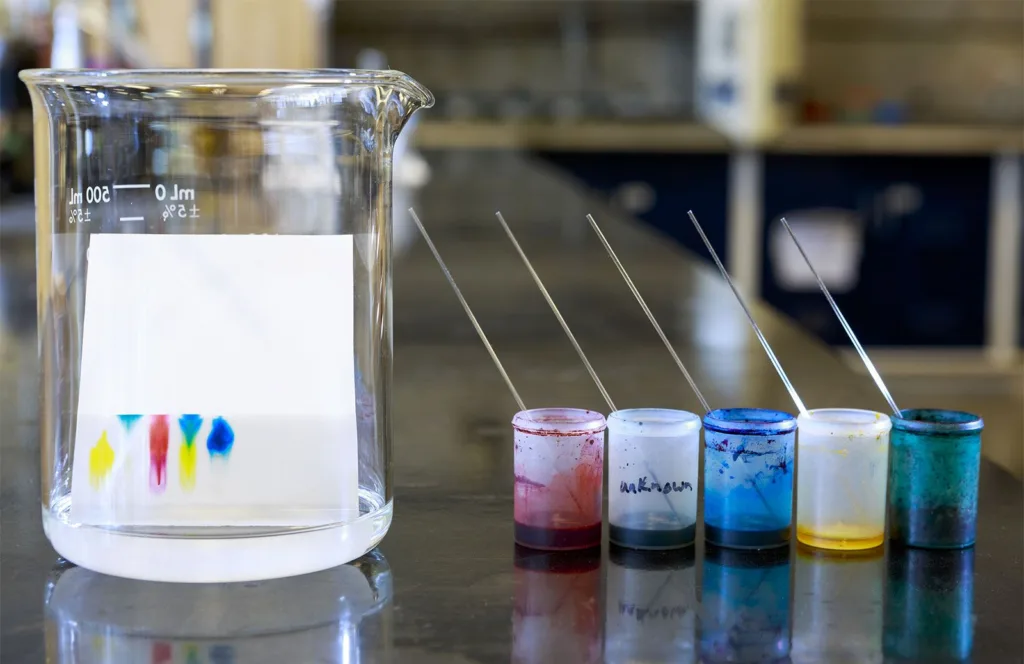Retardation factor (Rf) is an essential parameter in chromatographic separation. It is the ratio of the distance traveled by the substance of interest to the distance simultaneously traveled by the mobile phase. The Rf value helps to understand the relative affinities of a solute with the stationary and mobile phases, and it can be calculated usng the relative migration values of solute (analyte) and the solvent front.
The calculation of Rf value is a crucial step in chromatography, and it requires a few key components. First, the distance traveled by the solvent front from the origin to the center of the spot is measured. Second, the distance traveled by the solute from the origin to the center of the spot is measured. the Rf value is calculated by dividing the distance traveled by the solute by the distance traveled by the solvent front.
Rf = distance traveled by solute / distance traveled by solvent front
It is important to note that Rf values are dependent on the TLC plate and the solvent used. Therefore, it is essential to use the same plate and solvent in all experiments to ensure accuracy and reproducibility of results.
The Rf value is a critical parameter in chromatographic separation as it indicates whether the analyte (solute) prefers the stationary or mobile phase. If the Rf value is close to 1, it means that the analyte prefers the mobile phase and has low affinity for the stationary phase. On the other hand, if the Rf value is close to 0, it means that the analyte prefers the stationary phase and has low affinity for the mobile phase.
The calculation of retardation factor (Rf) is an essential step in chromatography. It helps to determine the relative affinities of a solute with the stationary and mobile phases, and it is calculated by dividing the distance traveled by the solute by the distance traveled by the solvent front. Rf values are dependent on the TLC plate and the solvent used, and they indicate whether the analyte (solute) prefers the stationary or mobile phase. By understanding Rf values, researchers can optimize their chromatographic separations and obtain accurate and reproducible results.
How Is Retardation Factor Calculated?
Retardation factor (Rf) is calculated by dividing the distance travelled by the substance of interest on a chromatographic medium by the distance travelled simultaneously by the mobile phase. The formula for calculating Rf is:
Rf = distance travelled by the substance of interest / distance travelled by the mobile phase
The distance travelled by the substance of interest is measured from the point of application to the centre of the spot or peak, while the distance travelled by the mobile phase is measured from the point of application to the solvent front. The Rf value is always a fraction or decimal and always less than 1.
To calculate Rf, frst measure the distance travelled by the mobile phase from the point of application to the solvent front. Then, measure the distance travelled by the substance of interest from the point of application to the centre of the spot or peak. Finally, divide the distance travelled by the substance of interest by the distance travelled by the mobile phase to obtain the Rf value.

How Do You Calculate Retardation Factor In Chromatography?
To calculate the retardation factor (Rf) in chromatography, you need to measure the distance traveled by both the solute (analyte) and the solvent front. The Rf value is the ratio of the distance traveled by the solute to the distance traveled by the solvent front. The formula for calculating Rf is:
Rf = Distance traveled by the solute / Distance traveled by the solvent front
To measure the distance traveled by the solute, you need to mark the spot where you applied the sample (known as the origin) and the spot where the solute stopped moving (known as the spot). Measure the distance between thee two spots using a ruler or measuring tape.
To measure the distance traveled by the solvent front, measure the distance between the origin and the solvent front. The solvent front is the point where the solvent has traveled to the end of the stationary phase.
Once you have measured both distances, plug them into the formula and calculate the Rf value. The Rf value is a dimensionless quantity and ranges between 0 and 1. A higher Rf value indicates that the solute has a higher affinity for the mobile phase than the stationary phase.
How To Calculate Retardation Factor In Thin-layer Chromatography?
To calculate the retardation factor (Rf) in thin-layer chromatography (TLC), the distance traveled by a compound of interest and the distance traveled by the solvent front must be measured. The Rf value is then calculated by dividing the distance traveled by the compound by the distance traveled by the solvent front. This parameter is dependent on the TLC plate and the solvent used.
To determine the distance traveled by the compound, the center of the spot is measured from the point of application to the center of the spot after development. The distance traveled by the solvent front is measured from the point of application to the solvent front after development.
It is important to note that the Rf value can vary depending on the TLC plate and the solvent used. Therefore, it is recommended to use the same TLC plate and solvent system when comparing Rf values of different compounds. Additionally, it is good practice to run standards alongsde the sample to verify the identity of the compound of interest.
In summary, to calculate the Rf value in TLC, follow these steps:
1. Measure the distance traveled by the compound of interest from the point of application to the center of the spot after development.
2. Measure the distance traveled by the solvent front from the point of application to the solvent front after development.
3. Divide the distance traveled by the compound by the distance traveled by the solvent front to obtain the Rf value.
Why Do We Calculate Rf Values?
In chromatography, Rf values are crucial to the experiment as they provide information about the behavior of the analyte or solute in the stationary and mobile phases. These values can be used to identify compounds, determine their purity, and evaluate the effectiveness of the chromatography method used. Some of the specific reasons why Rf values are calculated include:
1. Identification of compounds: Rf values can be used to identify compounds by comparing them to known standards. If the Rf value of a particular compound matches that of a known standard, it is likely that the unknown compound is the same as the standard.
2. Determination of purity: By measuring the Rf value of an analyte, we can determine how much of it is present in the sample. If the Rf value is high, it means the compound is more soluble in the mobile phase and less in the stationary phase, indicating that the sample may be impure.
3. Evaluation of chromatography method: Rf values can be used to evaluate the effectiveness of the chromatography method used. If the Rf values obtained are not consistent with the expected values, it may indicate that the method needs to be optimized for better results.
The calculation of Rf values is crucial in chromatography as it provides valuable information about the behavior of analytes in the stationary and mobile phases. It can be used to identify compounds, determine their purity, and evaluate the effectiveness of the chromatography method used.

Conclusion
The retardation factor (Rf) is a crucial parameter in chromatographic separation. It is the ratio of the distance traveled by the substance of interest to the distance simultaneously traveled by the mobile phase. To calculate Rf, we use the relative migration values of the solute and the solvent front. The Rf value provides information on the relative affinity of the solute with the stationary and mobile phases. It is an important parameter that determines the success of the chromatographic separation experiment. The Rf value is dependent on the TLC plate and the solvent used. Therefore, it is essential to choose the appropriate TLC plate and solvent to obtain an accurate Rf value. By understanding and calculating Rf, we can determine wether the analyte prefers the stationary or mobile phase, which is critical in the analysis of complex mixtures.
